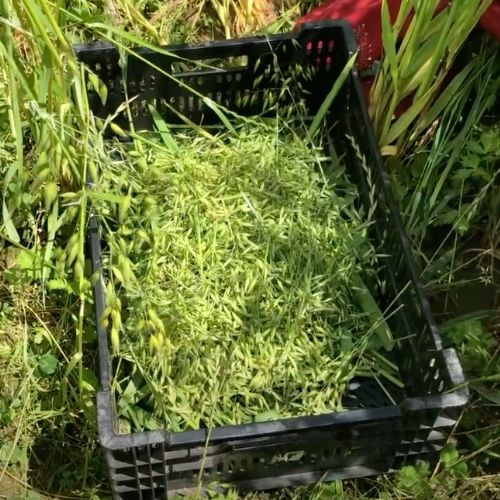Like many people, I take great pride in my work. One aspect in which I take special care is to make sure I’m only reporting on what the hard science has found. I’m not biased toward or against any one supplement or ingredient–part of the reason I have so far not endorsed any given product. I let the science speak for itself.
I mention that because I’ve researched Oat Straw (Avena sativa) for a variety of uses, and sometimes, frankly, it comes up short. For instance, there is no evidence that it can help with testosterone. But when it came to researching it for cognitive function, I couldn’t let that color my judgment.
key findings
A Lot of (Funded) Research
In scientific circles, some of the best data comes from what may seem like a simple process: gather a few dozen people; give half of them a sugar pill, the other half a test substance; don’t tell anyone, including the testers, who got what pill; have the two groups perform a task. Record the results.
In practice, however, these can be expensive, time consuming affairs, and a lot of people cut corners. That’s where the manufacturer of a substance can come in with funding and resources. Of course, that introduces the risk of bias in the research.

With Oat Straw, a leading manufacturer of its extract has funded what appears to be the overwhelming majority of the research into Oat Straw. The findings have all been peer-reviewed, and the authors have claimed no conflict of interest, but I wouldn’t be doing my job as a science writer unless I pointed this out.
Human Studies
The first study I could find was published some time ago in the Journal of Alternative and Complementary Medicine. In it, they tested placebo, 1,600 and 2,400 mg doses with elderly volunteers. They found significantly better results with the 1,600 mg dose than the other groups, especially regarding attention and concentration.
A second study was conducted some time later, this time with middle-aged participants, and with placebo, 800, or 1,600 mg doses. They found that 800 mg dose was the most effective, and this time found increases in memory, with fewer mistakes and less thinking time to a completed word-recall test.
Higher doses didn’t lead to any adverse effects, necessarily, but the lower doses in both trials were more effective. In an odd parallel to these findings, another study took 12 and 24 week assessments of cognitive function, and found that long-term use did not have any benefit. Researchers did note, however, that at baseline, their participants were already in the highest 10% of cognitive function, and therefore, may not have seen any results no matter what supplement they took.
Possible Mechanisms at Play
There are several proposed mechanisms at play, and all resulting from different teams of researchers. None of these studies listed funding from an Oat Straw manufacturer, though one team of researchers did receive funding from them on a separate study.
Animal Study
A clinical trial of laboratory animals yielded some interesting results that simply couldn’t be obtained through human trials. In the experiment, rats were given either no Oat Straw, a low dose, or a high dose, and then subjected to what researchers called “stress-inducing” tests; these included forced swimming and forcing them into encounters they tried to avoid. In the lower dose of Oat Straw, the animals had a better stress response, learned even under duress, and had better socialization after testing.
All of this may suggest that there is a hormonal element to Oat Straw’s efficacy in humans. If it is indeed mitigating our stress responses, it could explain why under the “stress” of cognitive testing the Oat Straw participants had better results.
Brain Scans
During a three-way placebo controlled test, participants were given an EEG (electroencephalogram) brain scan during rest and during a concentration test. Both Oat Straw groups had more stimulated brain activity during the test, but again, better statistical results were seen in the lower dose group.
Improved Blood-Flow
Results published in the Journal Hypertension indicate that Oat Straw increased blood flow, specifically in the middle cerebral artery. While their conclusions were focused on general cardiovascular health, another piece from Hypertension showed that cerebral blood flow and higher cognition are closely linked.
Conclusion
Bias can cut both ways; we can be more accepting of one thing because of our preconceived notions, or we can be less accepting. With Oat Straw, I’ve tried to keep an open mind to what the specific studies have shown regarding cognitive function, regardless of other claims about it. In the present studies, it appears that Oat Straw can improve mental performance, especially in the realms of memory and attention. These data hold better at lower doses and with populations that may have cognitive impairment.

There is, however, a risk of bias on the other side of these studies. Mainly that many of them appear to be funded by an Oat Straw manufacturer. Doubts regarding the validity of the findings may be allayed by the fact that the studies were still included in peer-reviewed journals, and that if anything, the studies indicate that very little Oat Straw is needed, and over a very short time.
No matter the case, as I’ve said many times, I can only report what the research says. In this case, Oat Straw seems to have an impact on stress response, brain-blood flow, and frontal lobe brain activity, which in clinical trials, appears to result in higher cognitive function.

